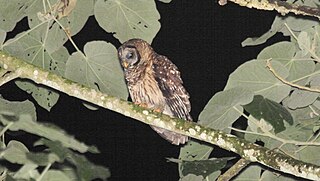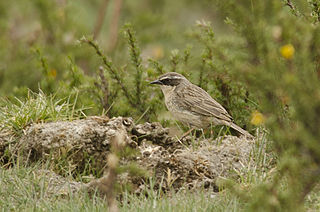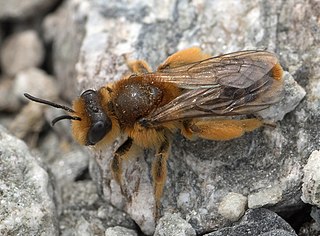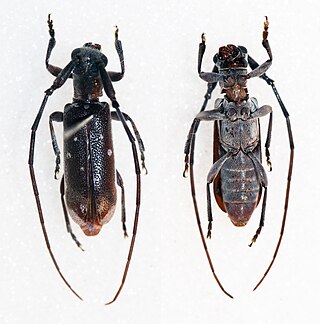Acipenser is a genus of sturgeons. With 17 living species, it is the largest genus in the order Acipenseriformes. The genus is paraphyletic, containing all sturgeons that do not belong to Huso, Scaphirhynchus, or Pseudoscaphirhynchus, with many species more closely related to the other three genera than they are to other species of Acipenser. They are native to freshwater and estuarine systems of Eurasia and North America, and most species are threatened. Several species also known to enter near-shore marine environments in the Atlantic, Arctic and Pacific oceans.
The lake sturgeon, also known as the rock sturgeon, is a North American temperate freshwater fish, one of about 25 species of sturgeon. Like other sturgeons, this species is a bottom feeder and has a partly cartilaginous skeleton, an overall streamlined shape, and skin bearing rows of bony plates on the sides and back.

Oligoryzomys fulvescens, also known as the fulvous colilargo, fulvous pygmy rice rat, or northern pygmy rice rat, is a species of rodent in the genus Oligoryzomys of family Cricetidae. It is found from southern Mexico through Central America into South America, where it occurs south into Peru and Brazil, and includes numerous synonyms, including the type species of the genus, Oryzomys navus Bangs, 1899. The taxonomy of this species is unresolved, and it may be found to contain more than one species. Its karyotype has 2n = 54-60 and FNa = 68–74.

The fulvous owl, or Guatemala barred owl, is a resident of the cloud forests of Central America. A medium-sized true owl, it has a round head, lacking ear tufts. Its typical coloration is warm dark brown or reddish brown on the back and lighter brown on the front with darker barring. Adults weigh approximately 600 grams (21 oz), with females being heavier. Its distribution is limited to highland regions of Guatemala, Honduras, and El Salvador. It inhabits elevations from 1,200 to 3,100 meters, and is fairly common within its range. Its behavior is poorly known, as are its population size and distribution. It is classified as a species of least concern by the International Union for Conservation of Nature, although it is considered endangered in Mexico.

Niviventer is a genus of rodent in the family Muridae endemic to Southeast Asia. It contains the following species:

The chestnut white-bellied rat is a species of rodent in the family Muridae. It is a small rodent with a distinct bright chestnut upper-coat and a white under-coat. The colour of the upper-coat is variable from very bright to a duller brown. The side of the body has a distinct margin where the upper and the under-coat meet. The upper-side of the tail is mostly brownish whereas the underside is whitish to flesh coloured. The species is mostly found in disturbed and undisturbed forest habitat. The species is known to scatter-hoard seeds in forests of eastern Himalayas.
The fulvous harvest mouse is a species of rodent in the family Cricetidae. It is found in El Salvador, Guatemala, Honduras, Mexico, Nicaragua, and the United States.

The brown illadopsis or brown thrush-babbler, is a species of bird in the family Pellorneidae. The species was first described by John Cassin in 1859. It is widely spread throughout the African tropical rainforest. Its natural habitats are subtropical or tropical dry forests and subtropical or tropical moist lowland forests.

The brown accentor is a species of bird in the family Prunellidae. It is found in Afghanistan, China, India, Kazakhstan, Mongolia, Nepal, Pakistan, Russia, Tajikistan, Turkmenistan, and Uzbekistan.

Hexaplex fulvescens, the giant eastern murex or giant Atlantic murex or tawny murex, is a species of sea snail, a marine gastropod mollusk in the family Muricidae, the murex snails or rock snails.
The Dominican snout is a species of snout butterfly that is endemic to Dominica, an island nation in the Caribbean Lesser Antilles.

Charaxes fulvescens, the forest pearl charaxes, is a butterfly in the family Nymphalidae.

Aphanoascus fulvescens is a mould fungus that behaves as a keratinophilic saprotroph and belongs to the Ascomycota. It is readily isolated from soil and dung containing keratin-rich tissues that have been separated from their animal hosts. This organism, distributed worldwide, is most commonly found in areas of temperate climate, in keeping with its optimal growth temperature of 28 °C (82 °F). While A. fulvescens is recognized as a geophilic fungal species, it is also a facultative opportunistic pathogen. Although it is not a dermatophyte, A. fulvescens has occasionally been shown to cause onychomycosis infections in humans. Its recognition in the laboratory is clinically important for correct diagnosis and treatment of human dermal infections.
Ceryx fulvescens is a moth in the subfamily Arctiinae. It was described by Francis Walker in 1854. It is found in the Republic of the Congo, the Democratic Republic of the Congo, Kenya, Lesotho, Mozambique, Rwanda, Somalia, South Africa, Zambia and Zimbabwe.

Eunidiini is a tribe of longhorn beetles of the subfamily Lamiinae. It was described by Téocchi et al. in 2010.

Eunidia is a genus of longhorn beetles of the subfamily Lamiinae.

Leioproctus fulvescens is a species of solitary bee belonging to the family Colletidae. This bee is endemic to the South Island of New Zealand, and its yellow-orange hair distinguishes it from all other New Zealand species of Leioproctus.
Eunidia batesi is a species of beetle in the family Cerambycidae. It was described by Olliff in 1889.

Eunidia thomseni is a species of beetle in the family Cerambycidae. It was described by William Lucas Distant in 1898. It is known from Tanzania, Cameroon, Chad, Niger, Ethiopia, Senegal, Mozambique, Botswana, Namibia, Saudi Arabia, the Central African Republic, Somalia, Uganda, South Africa, Yemen, Kenya, and Zimbabwe.

The Oriental Basin pocket gopher is a species of pocket gopher which is endemic to Mexico. It was first described in 1895 by Clinton Hart Merriam. It was considered to be a subspecies of Merriam's pocket gopher in the late 20th and early 21st century but has been reinstated as its own species. The IUCN Red List has evaluated it to be of least concern.












